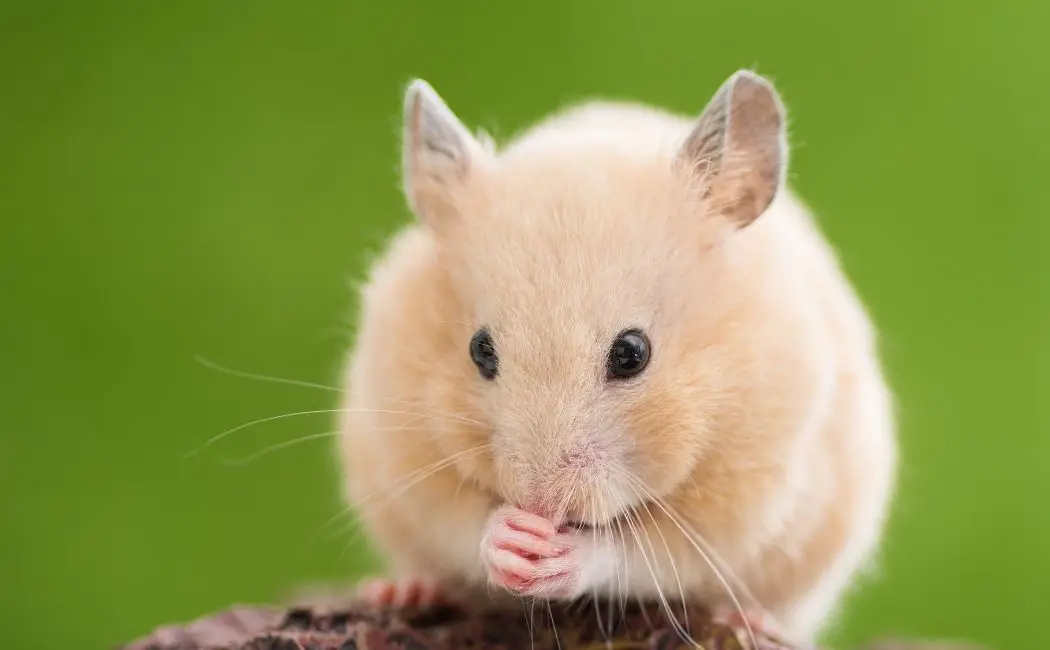Can Hamsters Mark Their Territory? (Answered!)
Yes, hamsters can mark their territory with their scent glands. These glands are more prominent in males than females, and when the male is excited, it will lick its scent glands until the entire area is wet. It will also scratch and rub itself as if the area is irritated. This behavior indicates that the hamster is marking its territory with its own unique scent.
What causes hamsters to mark their territory?
There are a number of reasons why hamsters mark their territory. The most common reason is to indicate ownership or dominance over an area. By marking their territory with scent glands, hamsters are able to communicate with other members of their species and establish social hierarchies.
Additionally, scent-marking may also serve as a form of communication during mating season, helping males attract females and vice versa. Finally, some experts believe that scent marking can help relieve stress in hamsters by releasing pheromones into the environment.
Are Male Hamsters Territorial?
When it comes to hamsters, there is a big difference between the sexes when it comes to aggression and territoriality. Females are much more likely to be aggressive and territorial than males. This is because females are naturally more protective of their nests and offspring. They will often fight other animals (including other hamsters) to protect their young.
Males, on the other hand, are generally much calmer and friendlier. They rarely show the same level of aggression as females do. However, they can still be territorial – just not as much as females usually are.
Are Female Hamsters Territorial?
Yes, female hamsters are territorial. They’re known to be more aggressive and difficult to handle than males, and they’re also more likely to exhibit territorial behavior. However, it’s important to note that both sexes can be territorial.
How do hamsters mark their territory?
Hamsters are small mammals that are known for their ability to store large amounts of food in their cheek pouches. They are also known for their scent glands, which they use to mark their territory.
The scent glands are located on the hamster’s flanks, or hips. They are more prominent in males than females. When a male hamster is excited, it will lick its scent glands until the entire area is wet. It will also scratch and rub itself as if the area is irritated. This behavior helps to spread the hamster’s scent and mark its territory.
Female hamsters also have scent glands, but they do not display the same behaviors as males. Instead, they simply release a stream of urine that contains their own unique scent. This allows them to mark their territory without having to engage in any special behaviors.
How often do hamsters mark their territory?
Hamsters are small, furry animals that are often kept as pets. They are known for being playful and active, but they can also be territorial. When it comes to marking their territory, hamsters will do so by urinating in specific areas.
How often a hamster marks its territory will depend on several factors, including the size of its habitat and the number of other hamsters it lives with. If a hamster has plenty of space to roam around in and isn’t sharing its home with another hamster, it may not need to mark its territory as often. However, if a hamster feels like its space is being threatened or if there is another animal in the home that it doesn’t get along with, it may start marking more frequently.
In general, you can expect your hamster to mark its territory every few days or so. If you notice your hamster starting to mark more frequently than usual, try giving it some extra attention and see if that helps reduce the behavior.
Do all hamsters mark their territory?
Do all hamsters mark their territory? The answer to this question is not a simple yes or no. There are many factors that can influence whether or not a hamster will mark its territory.
For example, the type of hamster may play a role. Some breeds, like the Syrian hamster, are more territorial than others and are more likely to mark their territory with urine or other secretions. Other factors that can influence whether or not a hamster marks its territory include things like its environment, diet, health, and even its temperament.
That said, it’s important to remember that all animals are different and therefore some individual hamsters may mark their territory even if they don’t fit into any of the above categories while others may not mark their territory at all regardless of these factors. Ultimately, it really depends on the individual animal and there is no definitive answer to this question.
How does territorial marking behavior vary among different hamster species?
There are many different species of hamsters, and each has its own unique way of marking its territory. Some common methods of territorial marking include urine spraying, cheek rubbing, and scent glands.
Urine spraying is perhaps the most well-known form of territorial marking in hamsters. This behavior involves the hamster urinating on objects or surfaces in its territory in order to leave its scent behind. Cheek rubbing is another common form of territorial marking, which involves the hamster rubbing its cheeks against objects or surfaces in its territory.
This action leaves behind a special secretion from the hamster’s scent glands, which helps to mark the area as being part of the hamster’s territory. Scent glands are located all over a hamster’s body, but there are two main types that are used for territorial purposes: anal glands and flank glands. Anal gland secretions are used to mark objects or surfaces that the hamster has urinated on, while flank gland secretions help to mark an area where the hamster has been sleeping or resting.
Hamsters will also sometimes engage in what is known as “drag-marking”, where they will drag their bodies along objects or surfaces in their territories in order to leave behind their scent.
Different species of hamsters vary somewhat in their use of these various territorial markers. For example, Syrian hamsters tend to be more likely to have urine spray than other species, while Chinese dwarf hamsters typically engage in more drag-marking behaviors.
However, all species of hamsters use some combination of these methods to mark their territories and keep other animals out.
What implications does territorial marking have for hamster care and welfare?
Territorial marking is a common behavior among hamsters in the wild. This behavior involves urine spraying and leaving droppings in specific areas to mark their territory. In captivity, hamsters may also engage in this behavior if they feel threatened or anxious. While territorial marking is a natural behavior for hamsters, it can be problematic for pet owners. Urine spraying can cause stains and odors on furniture and walls, and droppings can be difficult to clean up. This behavior may also be stressful for other pets in the household, such as cats or dogs.
There are several things that pet owners can do to minimize the impact of territorial marking on their homes and pets: -Provide your hamster with plenty of enrichment items, such as tunnels, toys, and hiding places.
A well-stimulated hamster is less likely to feel the need to mark its territory. -Clean any spots where your hamster has sprayed urine immediately; this will help discourage future markings in that area. -Consider using an odor neutralizer or air freshener specifically designed for pet odors; these products can help mask the scent of urine and make your home more pleasant for everyone involved. Territorial marking is a common but potentially problematic behavior among captive hamsters.
How can territorial marking behavior be managed in pet hamsters?
Hamsters are small, territorial animals that are known for their prominent cheek pouches. They are often kept as pets, and their unique behavior can make them interesting and entertaining companions. One of the most notable behaviors exhibited by hamsters is territorial marking, which involves urinating on objects in their environment to mark their territory. This behavior can be a nuisance for pet owners, but there are several ways to manage it effectively.
The first step in managing territorial marking behavior is to understand why hamsters do it. Territorial marking is a natural instinct for hamsters, and they will typically mark any new object or person that enters their territory. This includes things like furniture, walls, doors, and even people’s hands. Hamsters also have a strong sense of smell, so they use urine as a way to communicate with other members of their species. When another hamster smells the urine of another individual, it can tell things like how old that individual is and what its social status is within the group.
There are several ways to prevent or reduce territorial marking behavior in pet hamsters. The first is to provide plenty of opportunities for your hamster to explore and exercise outside of its cage. This will help keep its mind occupied and less likely to focus on marking its territory inside the cage. You can also try placing items like toys or treat balls inside the cage so that your hamster has something else to focus on besides urinating on everything.
What role does scent play in hamster territorial marking?
When it comes to hamster territorial marking, scent plays a big role. Hamsters are very scent-oriented creatures, and they use their noses to figure out a lot about their world. When it comes to marking their territory, they will often rub their bodies against objects in their environment to leave behind their scent. This helps them claim ownership over an area and also lets other hamsters know that they are there.
The scent is also important when it comes to social interactions between hamsters. They use scent to communicate with one another, and it can be used to convey a variety of messages. For example, when two hamsters meet for the first time, they will sniff each other’s behinds in order to get a better sense of who the other is. Scent can also be used as a way of showing aggression or dominance, as well as signaling that a particular area is off-limits.
Overall, scent plays a very important role in the lives of hamsters. It helps them mark their territory, communicate with one another, and navigate their world.
How does territorial marking behavior change as hamsters age?
As hamsters age, their territorial marking behavior changes in a few ways. First, older hamsters are less likely to mark their territory as often. This is because they tend to be less active and don’t explore their environment as much as younger hamsters do.
Second, older hamsters are more likely to mark their territory with urine rather than feces. This is because urine contains more scent molecules and thus can communicate more information about the hamster’s identity and social status than feces can.
Finally, older hamsters are more likely to mark their territory with both urine and feces than younger hamsters are. This behavior is thought to be a way of indicating that the Hamster considers its home range to be especially important and worth defending against intruders.
Can hamsters be trained not to mark their territory?
Hamsters are small, furry rodents that are popular pets around the world. Although they are often thought of as low-maintenance pets, hamsters can actually be quite high-maintenance when it comes to their living quarters. One of the most common problems that hamster owners face is territorial marking, which is when a hamster urinates in its enclosure to mark its territory. This behavior can be very frustrating for owners, but the good news is that it can be trained out of a hamster with some patience and perseverance.
The first step in training a hamster not to mark its territory is to ensure that its enclosure is clean and free of any potential sources of stress or anxiety. A clean cage will help your hamster feel comfortable and secure and will make it less likely to want to mark its territory. It’s also important to provide your hamster with plenty of toys and enrichment items so that it has something else to focus on besides marking its territory.
If your hamster does start marking its Territory, the best way to handle it is by immediately cleaning up any urine spots with a pet-safe cleaner. It’s important not to scold or punish your hamster for this behavior, as this will only increase Its stress levels and make the problem worse. Instead, simply clean up the messes promptly and continue providing your hamster with a clean, enriching environment.
What other behaviors are associated with hamster territorial marking?
When a hamster feels threatened by another animal or person, it may mark its territory with urine or feces. This behavior is known as territorial marking and is often seen in wild hamsters. Other behaviors associated with territorial marking include aggression, vocalization, and scent-marking.
Hamsters are naturally timid creatures and will usually only resort to territorial marking when they feel threatened or intimidated. Territorial marking is their way of saying “this is my territory and you’re not welcome here!” If you see a hamster exhibiting any of these behaviors, it’s best to give them some space and let them calm down.
What is the difference between hamsters and other animals that mark their territory?
The main difference between hamsters and other animals that mark their territory is that hamsters do it by urinating on objects, while other animals tend to use scent glands or urine spraying. Hamsters also have a much higher urine output than other animals, so they need to mark their territory more frequently. This behavior is thought to be mainly for territorial purposes, but it may also serve as a way for hamsters to communicate with each other.
How can you tell if a hamster is marking its territory?
When a hamster is marking its territory, it will often lick its scent glands or hip spots. These glands are more prominent in males than females, and when the male is excited, it will often lick them until they are wet. The hamster may also scratch and rub itself in this area as if it is irritated.
Is it harmful to hamsters if they mark their territory?
Hamsters are small, rodents that are often kept as pets. They are known for being very active and playful, and for their love of burrowing and tunneling. Hamsters also have a strong sense of smell, which they use to mark their territory.
While marking their territory is a perfectly natural behavior for hamsters, it can be harmful if they do it too much. When hamsters mark their territory with urine, they release a chemical called ammonia into the air. Ammonia is a gas that is poisonous to both humans and animals and can cause respiratory problems if inhaled in large quantities.
So, while marking their territory is not inherently harmful to hamsters, it can be if they do it excessively. If you notice your hamster markings its territory more than usual, try to provide more space for them to roam and explore. This will help reduce the amount of ammonia in the air and make it safer for both your hamster and your family.
What can you do to stop a hamster from marking its territory?
There are a few things you can do to stop your hamster from marking its territory. The first is to provide it with plenty of toys and playtime. This will help keep its mind off of marking and give it something else to focus on.
Secondly, you can try training your hamster with positive reinforcement; rewarding it when it goes in the right place and ignoring or lightly scolding it when it goes in the wrong place. Finally, make sure that its cage is clean and comfortable; a dirty or cramped cage can be one of the leading causes of territory-marking behavior in hamsters.







